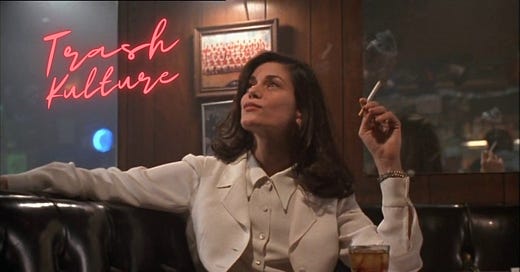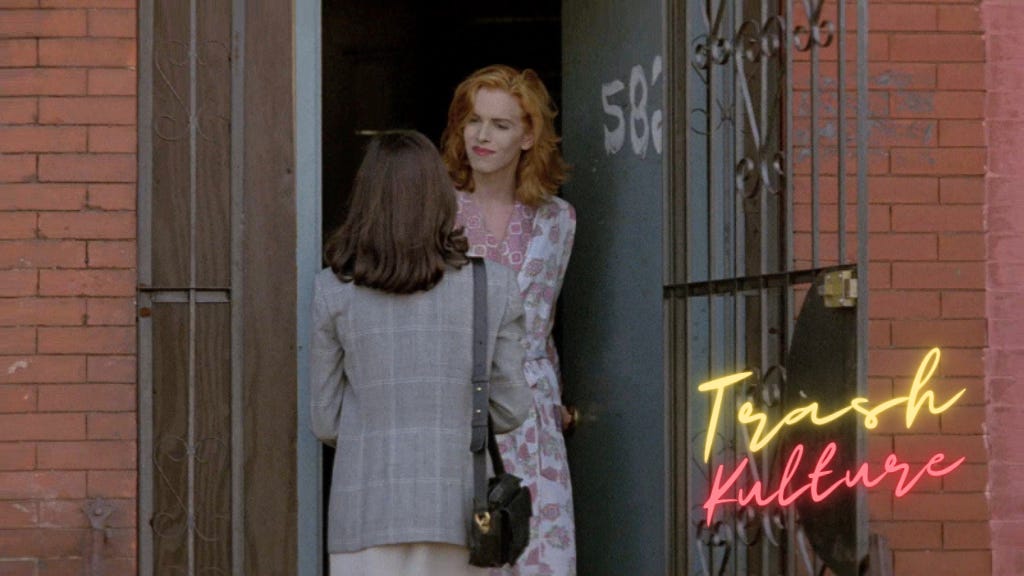Female Trouble: Dahl's The Last Seduction and Gender Anxiety in the Erotic Thriller
Trash culture as a way to understand and fight the conservative white male Id
This post contains spoilers for The Last Seduction. However, the movie came out in 1994, so I’m not going to feel too bad about it. if you want to watch it before reading, this is your chance.
In the final climactic scene of John Dahl’s The Last Seduction (1994) femme fatale Bridget Gregory goads her lover/victim, Mike, into enacting a rage-filled rape fantasy that will allow her to send him to prison while she escapes scot-free.
As witnesses to this 100th minute twist we, the audience, are disturbed and titillated by the culmination of Bridget’s sociopathic scheme. But we’re not meant to be shocked by Mike’s actions. It’s only natural he could be so easily manipulated into sexual violence. What more could you expect? His masculinity has been challenged. He’s been labeled a “faggot” for being duped into a past relationship with trans woman. Surely, any man would have done the same in his circumstances. And in fact our anti-hero Bridget was counting on it.
Viewing the film from the perspective of 2023, the ultimately pitiful, degraded and broken Mike offers a perfect expression of the deep-seated fears of conservative white men. It doesn’t take a close viewing of The Last Seduction to realize that the current trend of fascist, anti-trans, men’s rights panic was telegraphed long before our current, regrettable age.
That said, The Last Seduction is very much a film of it’s time: One in a long line of neo-noir/erotic thrillers that were steaming up theaters from the late 80s through the 90s. Dahl’s movie bursts with genre tropes found in its contemporaries like The Color of NIght, Dressed to Kill, Body of Evidence, Jade, and Sliver. There’s oodles of flesh and sex, which punctuate a twisted plot where adults with questionable morals make fools and victims of the good and decent.
The movie follows the unapologetic Bridget (brilliantly acted by Linda Fiorentino) in her brutal campaign to fuck over every man she comes across in order to (checks notes) get a better apartment in Manhattan. We meet her as a high-pressure, direct-sales girl-boss who belittles sweaty dudes as they try to push rubes into dubious investment coins (you know, like the ones sold daily on TV in between Fox n’ Friends segments). Over the next 110 minutes, Bridget is unstoppable. After boosting a bag of drug cash from her husband (Bill Pullman) she gets stranded on the run outside of Buffalo. There she seduces the insufferable Mike (Peter Berg) and makes him a patsy in her scheme to eliminate her husband and abscond with both the stolen cash and a life-insurance payout.
Calling Bridget a force would be an understatement. She is everything that men have always feared: independent, wildly smart, manipulative, confidently attractive, sexually aggressive and frustratingly aloof and impolite. She doesn’t give a fuck. She sure as shit won’t smile for you. At no point does she tell the truth about her feelings or intentions. It’s no accident her name can be so easily turned into “Bitchet,” as her husband does early in the third act.
If Bridget is every man’s worst female fear, then Mike is a fever vision of masculinity at nadir. He’s a white collar working man schlepping insurance. He’s trapped in a small town, despondent, knowing he was meant for more because it’s the promise of his position as a straight white American male.
Our introduction to Mike is a close up of his left hand. A line of tarnish encircles his ring finger signaling that his wedding band, and thus his marriage, must have been quick, fake and cheap (though his friend assures him booze can remove the stain). It becomes quickly clear that maybe he’s a straight up misogynist as he describes the women of his home town as “anchors” (more the drowning type than the keeping-you-in-place type) But then, in walks Bridget who he clocks almost instantly as a way out.
After a few attempts to start a conversation he is feeling increasingly emasculated by her dismissals before taking his biggest, um … swing: “I’m hung like a horse,” he says.
Sure, guy.
Mike is a fine representation of mediocre white dude fragility. He feels his power diminished. He feels duped by a changing culture he can’t understand and he believes his masculinity is in danger as every turn from a powerful woman. He’s been shown how small he is and it’s a reality antithetical to who he believes himself to be. If it were 2023 he’d be primed to be red-pilled.
Of course, we learn later why Mike is supposedly so damaged. In Buffalo, he’d fallen in love with a trans woman named Trish. They’d married quickly, before becoming sexually intimate. Mike discovers his partners transitional status and abandons her to return home.
Bridget learns about Trish and tracks her down. The only clear glimpse we have of her in the movie is a silent long shot as she steps from behind the spray painted doorway of a trashy Buffalo apartment. She is dressed in a flowery kimono with the pale Kabuki-adjacent make-up so popular in late-millennial representations of trans women.
It’s because of the threat of reuniting with Trish, the movie tells us, that Mike is willing to go to extremes to escape. He’s so frightened of trans-identity he is willing to kill — a proverbial trapped animal willing to gnaw off his own limb to survive.
Mike’s mind-boggling fear of transgender people is not unique in the genre. The erotic thrillers of the 80s and 90s were more than happy to traffic in trans paranoia. The best example of the trope is Dressed to Kill, Brian De Palma’s giallo-influenced neo-noir featuring a homicidal trans woman.
But the depiction of transgender individuals as dangerous or disturbed people can also be seen in movies like The Crying Game and The Color of Night. The latter film, starring Bruce Willis as a color-blind psychologist, features a character who suffers gender dysphoria due to prolonged abuse. Again, gender non-conformity is pathologized. But even worse, it’s tangled up in lurid eroticism, as the character engages in graphic hetero sex with Willis, often kinky and sometimes submerged.
The examples abound outside the genre too, and start from the very beginning of American film. One of the best contemporary sources of information on the subject is the 2022 documentary Disclosure (available on Netflix). But what’s troubling about trans characters in erotic thrillers is that they are so deeply sexualized.
Sure, film is often just a reflection of society. But from our place in 2023 it’s easy to draw a line between sexualized depictions of trans bodies in the 80s and 90s and modern-day conservative anti-trans policies. If all you’ve ever seen of trans people are the depicitions in media, including erotic thrillers, it’s easy to make-believe that you’re fighting “groomers” and cultural villains.
A modern read of Mike’s ultimate fate sounds like something your might hear in a Ron DeSantis anti-woke tirade. Here’s a dude who fell victim to woke culture and feminism. Not only was he victimized by a trans woman, he was “falsely” accused of rape by a duplicitous woman who was literally asking for it, and is now serving time despite being an innocent man.
But is Mike so incredibly innocent? Not really. He has a low opinion of women. He harasses Bridget mercilessly when they meet. He’s prone to violent outbursts and is willing to attempt the premeditated murder of Bridget’s husband. When she goads him on, he is sexually aggressive with her in a way that reveals it’s what he’s actually always wanted.
In the end, there aren’t really any redeemable characters in The Last Seduction. Everyone is terrible. But that’s not uncommon for trash culture. And it doesn’t mean that the whole movie is irredeemable.
In fact, Fiorentino’s performance is incredible. The score is wonderfully jazzy and the film-making strikes a wonderful noir tone. It’s a disarming and completely bonkers flick. Back in the day, Roger Ebert named it one of the best films of the year.
I think we can enjoy wallowing in the extremes of movies like The Last Seduction and its erotic thriller kin. But I also think it’s important that we remind ourselves that representations of the “othered” in media have consequences. And when we are not part of those communities, we don’t have to deal with those consequences. That makes it even more imperative that we do everything we can to fight and right the wrongs of those who have gone before us.
The best way to watch The Last Seduction is to call it what it is: a paranoid fantasy from the id of the American white conservative male. If it can help us understand them, it can help us defeat their shitty policies. That’s how trash culture can win.
The Last Seduction is part of an excellent erotic thriller collection currently streaming on the Criterion Channel. You should check it out.









